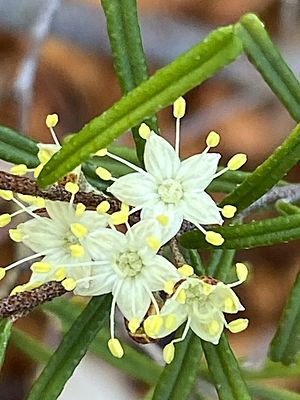St Helens wax flower facts for kids
Quick facts for kids St Helens wax flower |
|
|---|---|
 |
|
| In the ANBG | |
| Conservation status | |
| Scientific classification | |
| Genus: |
Phebalium
|
| Species: |
daviesii
|
The Phebalium daviesii, also known as the St Helens wax flower or Davies' wax flower, is a special kind of shrub. It only grows in a small area in Tasmania, Australia. This plant is covered in shiny silver or rusty-coloured scales. It has narrow, wedge-shaped leaves with a small notch at the tip. Its flowers are white to cream-coloured and have five petals.
Contents
What Does It Look Like?
The St Helens wax flower is a shrub that can grow between 1 and 3 meters tall. Its branches and leaves are covered in tiny, shiny scales that look silver or rusty.
Its leaves are thin and shaped like a wedge, about 20 mm long and 1 to 3 mm wide. The tip of each leaf has a small notch. The top surface of the leaves is smooth and hairless.
The flowers are white or cream. They grow in small clusters called umbels at the ends of the branches. Each flower sits on a short stem about 4 mm long. The flowers have five petals that are shaped like wide ovals, about 3 mm long and 2 mm wide. This plant usually blooms from September to November.
Naming the St Helens Wax Flower
The St Helens wax flower was first officially described in 1859. A scientist named Joseph Dalton Hooker gave it its formal name, Phebalium daviesii. He wrote about it in a book called The botany of the Antarctic voyage of H.M. Discovery ships Erebus and Terror. III. Flora Tasmaniae.
Where Does It Live?
This unique wax flower is found in only one small place. It grows along about 4.5 kilometers of the George River. This river is near the town of St. Helens on Tasmania's north-east coast. It likes to grow in forests where Eucalyptus viminalis trees are common, with smaller heath plants growing underneath.
Protecting This Rare Plant
The St Helens wax flower is a very rare plant. The Australian Government lists it as "critically endangered." This means it is at a very high risk of disappearing forever.
For many years, people thought this plant was extinct because no one had seen it since 1892. But in 1990, it was found again! However, in 2001, only 23 grown plants were counted.
The biggest problems for this plant are its very small population. It is also easily damaged by floods. Another threat is a type of fungus called Phytophthora cinnamomi, which can make the plants sick.
Growing St Helens Wax Flower
It is possible to grow the St Helens wax flower from cuttings. Some plant nurseries have successfully grown this plant. This helps to increase its numbers and protect it.
A Special Flower for Tasmania
In 2001, Australia celebrated 100 years since its states joined together to form a country. Each Australian state chose a native flower to represent it. The St Helens wax flower was chosen as the special "Tasmanian Federation Flower."
See also
 In Spanish: Phebalium daviesii para niños
In Spanish: Phebalium daviesii para niños


